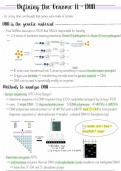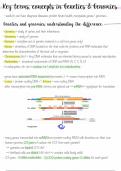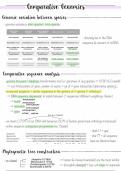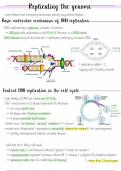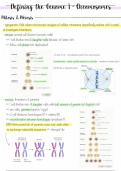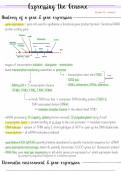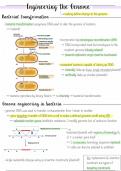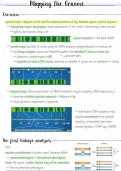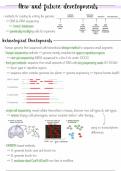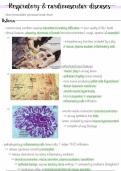Imperial College London (ICL)
Latest uploads at Imperial College London (ICL). Looking for notes at Imperial College London (ICL)? We have lots of notes, study guides and revision notes available for your school.
-
450
-
1
-
29
Courses at Imperial College London (ICL)
Notes available for the following courses at Imperial College London (ICL)
Popular books Imperial College London (ICL)
Latest notes & summaries Imperial College London (ICL)
Lecture notes from Imperial College London, Medical Biosciences BSc, 2nd year, genetics and genomics (GEN) module. Focus on genomic DNA. How do we know it is the DNA that genes are made of? In fact, for a long time it was thought that genes must be made of protein. We'll describe how this idea was disproved. Once it was realised that genes were DNA, techniques for analysing DNA burgeoned and gave rise to modern molecular genetics and genomics. We will review the basic principles of some of t...
Lecture notes from Imperial College London, Medical Biosciences BSc, 2nd year, genetics and genomics (GEN) module. What are Genetics and Genomics and why are they so important? As more and more was learned about genes, and the chromosomes that carry them, the importance of genomes emerged. Genomics allows us to study how all this genetic material works together to underpin complex characteristics. These days the news is full of good and bad stories about the influence of Genetics and Genomics...
Lecture notes from Imperial College London, Medical Biosciences BSc, 2nd year, genetics and genomics (GEN) module. By comparing the sequences of different species we can identify sequences that have been conserved over long periods of evolution and so are likely to have important biological functions. You will also see how the extent of such sequence conservation can be used to measure evolutionary relationships between the species. Similarly, when comparing sequences repeats within a single ...
Lecture notes from Imperial College London, Medical Biosciences BSc, 2nd year, genetics and genomics (GEN) module. Focus on replication of the genome. Before a cell divides, the entire genome of 3 billion base pairs must first be copied: accurately, quickly and just once per cell cycle. During this replication, chromosomal DNA must be unwound without getting tangled or suffering breakages and, if damage occurs, it must be repaired. Failure to meet any of these requirements may result in damag...
Lecture notes from Imperial College London, Medical Biosciences BSc, 2nd year, genetics and genomics (GEN) module. Focus on nuclear chromosomes: learn how 2 metres of DNA is somehow packaged into these tiny chromosomes and understand some key features of chromosomes that determine their structure and function. Understand the differences between autosomes, sex chromosomes and mitochondrial chromosomes, and their association with disease. learning objectives: - Recall the changes in numbe...
Lecture notes from Imperial College London, Medical Biosciences BSc, 2nd year, genetics and genomics (GEN) module. How is genomic DNA expressed, and how is it that different cell types with the same genome receive different instructions? In these notes, I delve deeper into transcription, and how it is affected by the arrangement of chromatin in the nucleus. I review the process of transcription itself as well as the epigenome - the set of DNA and histone modifications that regulates gene expr...
Lecture notes from Imperial College London, Medical Biosciences BSc, 2nd year, genetics and genomics (GEN) module. Description of genome engineering methods, particularly in mammals, and the principles underlying them. Nowadays, we can now modify genotypes of most organisms directly, quickly and radically, using a growing array of genome engineering methods. Most of these involve introducing DNA into cells where it integrates into the genome using DNA repair pathways. The latest methods also ...
Lecture notes from Imperial College London, Medical Biosciences BSc, 2nd year, genetics and genomics (GEN) module. These notes describe the ways in which genetic linkage maps and physical maps are generated and combined. I describe Genome-Wide Association Studies, which compare the genome sequences of many individuals in distinct populations, in order to locate regions that determine multi-genic phenotypes such as height or diabetes. learning objectives: - Explain the principles of link...
Lecture notes from Imperial College London, Medical Biosciences BSc, 2nd year, genetics and genomics (GEN) module. "In this last session we will review new and emerging methods, such as single cell sequencing and CRISPR-based genome engineering, and see how they are set to transform areas such a gene therapy, personalised medicine, ageing and the use of non-human organisms. We will also touch on the potential risks and ethical issues raised by these developments." learning objectives: ...
Lecture notes from Imperial College London, Medical Biosciences BSc, 2nd year, cardiovascular and thoracic biology (CTB) module. Lecture 9 on respiratory and cardiovascular diseases: investigate what happens when homeostatic processes break down, thereby leading to disease. We will be looking at two respiratory diseases, namely asthma and chronic obstructive pulmonary disease (COPD), and two cardiovascular diseases, namely atherosclerosis and pulmonary hypertension. Learning objectives: ...


